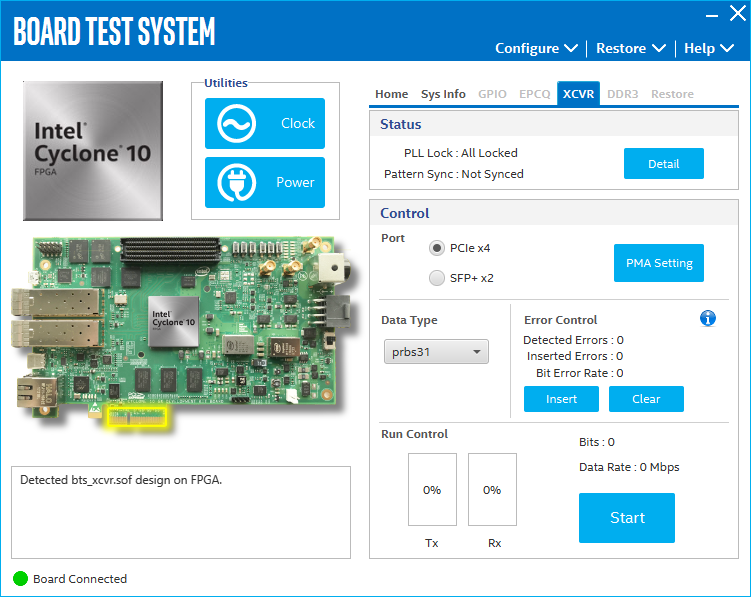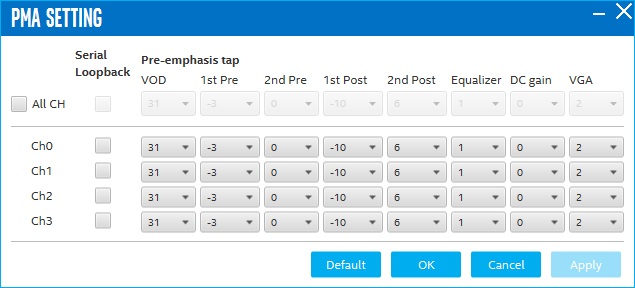Visible to Intel only — GUID: cyo1512069984556
Ixiasoft
5.3.5. The XCVR Tab
This tab allows you to perform loopback tests on the PCIe* and SFP+ ports.
Figure 15. The XCVR Tab


Status
Displays the following status information during a loopback test:

- PLL lock: Shows the PLL locked or unlocked state.
- Pattern sync: Shows the pattern synced or not synced state. The pattern is considered synced when the start of the data sequence is detected.
- Details: Shows the PLL lock, pattern sync status and number of errors for a single channel.

Port
Allows you to specify which interface to test. The following port tests are available:
- PCIe*
- SFP+
PMA Setting
Allows you to make changes to the PMA parameters that affect the active transceiver interface. The following settings are available for analysis:
- Serial Loopback: Routes signals between the transmitter and the receiver.
- VOD: Specifies the voltage output differential of the transmitter buffer.
- Pre-emphasis tap:
- 1st pre: Specifies the amount of pre-emphasis on the pre-tap of the transmitter buffer.
- 2nd pre: Specifies the amount of pre-emphasis on the second pre-tap of the transmitter buffer.
- 1st post: Specifies the amount of pre-emphasis on the first post tap of the transmitter buffer.
- 2nd post: Specifies the amount of pre-emphasis on the second post tap of the transmitter buffer.
- Equalizer: Specifies the AC gain setting for the receiver equalizer in four stage mode.
- DC gain: Specifies the DC gain setting for the receiver equalizer in four stage mode.
- VGA: Specifies the VGA gain value.

Data Type
Specifies the type of data contained in the transactions. The following data types are available for analysis:
- PRBS 7: Selects pseudo-random 7-bit sequences.
- PRBS 15: Selects pseudo-random 15-bit sequences.
- PRBS 23: Selects pseudo-random 23-bit sequences.
- PRBS 31: Selects pseudo-random 31-bit sequences.
- high_freq: Selects highest frequency divide-by-2 data pattern 10101010.
- low_freq: Selects lowest frequency divide-by-33 data pattern.
Error Control
Displays data errors detected during analysis and allows you to insert errors:
- Detected errors: Displays the number of data errors detected in the hardware.
- Inserted errors: Displays the number of errors inserted into the transmit data stream.
- Insert: Inserts a one-word error into the transmit data stream each time you click the button. Insert is only enabled during transaction performance analysis.
- Clear: Resets the Detected errors and Inserted errors counters to zeroes.
Run Control
- Start: Initiates the selected ports transaction performance analysis.
Note: Always click Clear before Start.
- Stop: Terminates transaction performance analysis.
- TX and RX performance bars: Show the percentage of maximum theoretical data rate that the requested transactions are able to achieve.